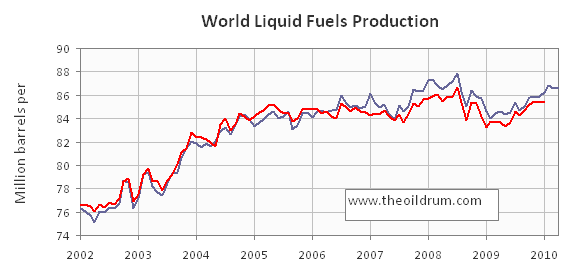Selon eux, les 6 premier mois de 2011 seront au dessus (max 86,91 mbj pour avril 2011).

Modérateurs : Rod, Modérateurs





Moi, ce que je vois surtout, c'est que même pour l'EIA la production tous liquides hors OPEC semble avoir piqué en novembre 2009 ! Elle ne repasse pas la barre des 51 Mb/j avant fin 2011.Yves a écrit : D'après l'EIA : Total World Production = 86,64 mbj en juillet 2008
Selon eux, les 6 premier mois de 2011 seront au dessus (max 86,91 mbj pour avril 2011).



C' est ce que j' ai entré hier à cet endroit.irinet a écrit :Et nouveau message alarmiste de l'armée américaine. Ils voient bien la production manquer d'arriver à la demande à court terme :
http://www.guardian.co.uk/business/2010 ... ion-supply
Il semblerait donc qu'ils pensent bien que ça a eu lieu.


....et quels sont ces programmes de developpement CTL de l' armée US ?Aerobar a écrit :Ce n'est qu'un léger pet produit par le lobby du CTL, très actif aux USA et qui utilise l'argument du PO et de la sécurité énergétique de l'armée américaine pour développer ses usines.

energy_isere a écrit :...et quels sont ces programmes de developpement CTL de l' armée US ?
Je ne crois pas avoir vu un scoop des studio Aerobarfilm sur le sujet. Sauf erreur de ma part.
Charbon vole (16 avril 2008)le nuisible de service a écrit :l'US Navy envisage de construire une unité CTL dans l'Indiana, dans le sillage de l'US Air Force qui pense en monter une dans le Montana.

Aerobar a écrit :energy_isere a écrit :...et quels sont ces programmes de developpement CTL de l' armée US ?
Je ne crois pas avoir vu un scoop des studio Aerobarfilm sur le sujet. Sauf erreur de ma part.Charbon vole (16 avril 2008)le nuisible de service a écrit :l'US Navy envisage de construire une unité CTL dans l'Indiana, dans le sillage de l'US Air Force qui pense en monter une dans le Montana.
et comme je le disais ici : viewtopic.php?p=271491#p271491 la tendance est plutot au kerozéne biofuel.Oct. 2009: Air Force abandons plans to develop CTL plants
On October 21, 2009, the Air Force announced it had cancelled plans to build coal-to-liquids fuel plants as a means of producing alternative jet fuels. Under the Bush administration, the Air Force - which makes up 10 percent of U.S. jet fuel demand - had been pushing to drive the development of a domestic CTL market. The decision to abandon these plans represents a policy shift under the Obama administration and raises doubts about the viability of developing a CTL industry in the U.S.[8]

Avec 86,6 mb/j, la demande de pétrole en 2010 devrait dépasser le précédent record de 2007 estime l’AIE (Yahoo)
jeudi 15 avril bréve de contreinfo
Global oil demand will hit a record high this year, the International Energy Agency (IEA) said on Tuesday, revising up consumption estimates as the world economy recovers from recession.
The Paris-based adviser to industrialized economies raised its forecast for world oil demand growth this year to 1.67 million barrels per day (bpd), up 100,000 bpd.
The agency said in its monthly Oil Market Report that world oil demand would reach an average of 86.60 million bpd this year, up from 84.93 million in 2009.
The previous record high for world oil demand was 86.5 million bpd in 2007 before the onset of the global financial crisis and economic slowdown.
"There are signs of oil demand picking up in North America and the Pacific, Asia and the Middle East although consumption in Europe still looks weak," David Fyfe, head of the IEA’s Oil Industry and Markets Division, told Reuters.
But the extra demand will largely be met by production from outside the Organization of the Petroleum Exporting Countries.
The IEA raised its forecast for non-OPEC output in 2010 by 220,000 bpd to around 52.0 million bpd due to higher output by OECD countries. Overall, non-OPEC supply is expected to rise by around 500,000 bpd this year.
As a result, the IEA estimated demand this year for OPEC crude and stocks would fall by 200,000 bpd to 29.1 million bpd.
Sources Yahoo


http://europe.theoildrum.com/node/6477#moreOilwatch Monthly May 2010
Posted by Rembrandt on May 18, 2010


on pourrait finallement quitter le plateau peut etre plus vite que prevu...Jay Taylor: Okay. So, about that time, if I am correct about this, Saudis were producing about 10 million barrels of oil a day. I seem to recall you saying somewhere that they were projecting 50 million barrels day and then they cut it back to about 12, 12.5 million barrels a day. Have they been able to reach that level of production? Are the Saudis putting out anything like that now as far as you know?
Matthew Simmons: Well, it depends on who you listen to. If you listen to the pronouncements from the Saudi Petroleum Ministry, they have the ability today to produce about 12.5 million barrels a day. If you listen to some of the insiders, they sound like they are struggling to stay close to 8.